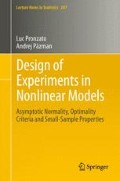Abstract
Among the major difficulties that one may encounter when estimating parameters in a nonlinear model are the nonuniqueness of the estimator, its instability with respect to small perturbations of the observations, and the presence of local optimizers of the estimation criterion. Classically, those issues are ignored at the design stage: the designs of Chap. 5 are based on asymptotic local properties of the estimator; the approaches of Chap. 6 make use of an assumption (\({\rm H}_{\mathcal{S}}\), p. 183) which allows us to avoid these difficulties. The main message of this chapter is that estimability issues can be taken into account at the design stage, through the definition of suitable design criteria. This forms a difficult area, still under development. Several new notions will be introduced, and a series of examples will illustrate the importance of the geometry of the model.
Access this chapter
Tax calculation will be finalised at checkout
Purchases are for personal use only
Notes
- 1.
- 2.
This is true for almost any θ (in the sense of zero Lebesgue measure on compact subsets on ℝ 3); notice that the model is not identifiable for θ 1 = 0.
References
Atkinson, A., K. Chaloner, A. Herzberg, and J. Juritz (1993). Optimal experimental designs for properties of a compartmental model. Biometrics 49, 325–337.
Atkinson, A. and D. Cox (1974). Planning experiments for discriminating between models (with discussion). J. Roy. Statist. Soc. B36, 321–348.
Bates, D. and D. Watts (1980). Relative curvature measures of nonlinearity. J. Roy. Statist. Soc. B42, 1–25.
Chavent, G. (1983). Local stability of the output least square parameter estimation technique. Matematicada Applicada e Computacional 2(1), 3–22.
Chavent, G. (1987). Identifiability of parameters in the output least square formulation. In E. Walter (Ed.), Identifiability of Parametric Models, Chapter 6, pp. 67–74. Oxford: Pergamon.
Chavent, G. (1990). A new sufficient condition for the wellposedness of non-linear least-square problems arising in identification and control. In A. Bensoussan and J. Lions (Eds.), Analysis and Optimization of Systems, Lecture Notes in Control and Inform. Sci., vol. 144, pp. 452–463. Springer.
Chavent, G. (1991). New size × curvature conditions for strict quasiconvexity of sets. SIAM J. Control Optim. 29(6), 1348–1372.
Clyde, M. and K. Chaloner (2002). Constrained design strategies for improving normal approximations in nonlinear regression problems. J. Stat. Plann. Inference 104, 175–196.
Demidenko, E. (1989). Optimization and Regression. Moscow: Nauka. [In Russian].
Demidenko, E. (2000). Is this the least squares estimate? Biometrika 87(2), 437–452.
Hill, P. (1978). A review of experimental design procedures for regression model discrimination. Technometrics 20, 15–21.
Kieffer, M. and E. Walter (1998). Interval analysis for guaranteed nonlinear parameter estimation. In A. Atkinson, L. Pronzato, and H. Wynn (Eds.), MODA5 – Advances in Model-Oriented Data Analysis and Experimental Design, Marseilles (France), June 1998, pp. 115–125. Heidelberg: Physica Verlag.
Koopmans, T. and O. Reiersøl (1950). The identification of structural characteristics. Ann. Math. Statist. 21(2), 163–181.
Pázman, A. (1984a). Nonlinear least squares – uniqueness versus ambiguity. Math. Operationsforsch. Statist. Ser. Statist. 15, 323–336.
Pázman, A. (1993b). Nonlinear Statistical Models. Dordrecht: Kluwer.
Pázman, A., S. Bilenkaya, J. Bystrický, Z. Janout, and F. Lehar (1969). The problem of un-ambiguity of phase-shift analysis I: Description of a powerful discriminating criterion. Czech J. Physics B19, 882–890.
Pronzato, L. and E. Walter (2001). Eliminating suboptimal local minimizers in nonlinear parameter estimation. Technometrics 43(4), 434–442.
Ross, G. (1990). Nonlinear estimation. New York: Springer.
Walter, E. (1982). Identifiability of State-Space Models. Berlin: Springer Verlag.
Walter, E. (Ed.) (1987). Identifiability of Parametric Models. Oxford: Pergamon Press.
Walter, E. and L. Pronzato (1995). Identifiabilities and nonlinearities. In A. Fossard and D. Normand-Cyrot (Eds.), Nonlinear Systems. Modeling and Estimation, Chapter 3, pp. 111–143. London: Chapman & Hall.
Walter, E. and L. Pronzato (1997). Identification of Parametric Models from Experimental Data. Heidelberg: Springer.
Author information
Authors and Affiliations
Rights and permissions
Copyright information
© 2013 Springer Science+Business Media New York
About this chapter
Cite this chapter
Pronzato, L., Pázman, A. (2013). Identifiability, Estimability, and Extended Optimality Criteria. In: Design of Experiments in Nonlinear Models. Lecture Notes in Statistics, vol 212. Springer, New York, NY. https://doi.org/10.1007/978-1-4614-6363-4_7
Download citation
DOI: https://doi.org/10.1007/978-1-4614-6363-4_7
Published:
Publisher Name: Springer, New York, NY
Print ISBN: 978-1-4614-6362-7
Online ISBN: 978-1-4614-6363-4
eBook Packages: Mathematics and StatisticsMathematics and Statistics (R0)

